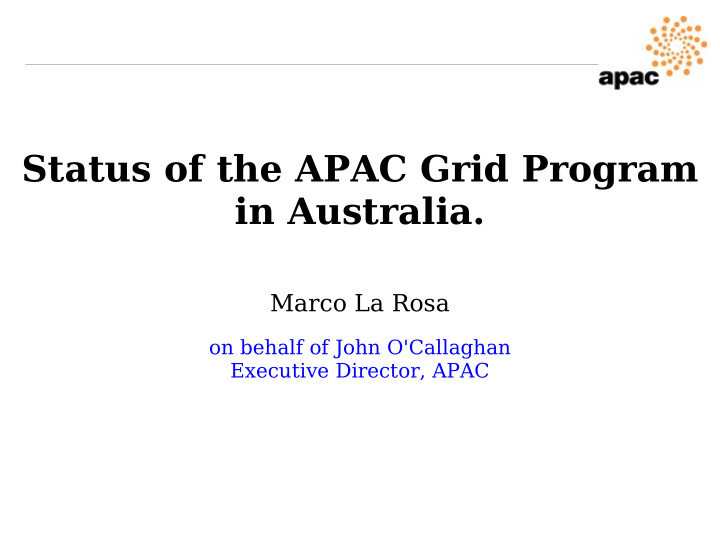



Status of the APAC Grid Program in Australia. Marco La Rosa on behalf of John O'Callaghan Executive Director, APAC
APAC Australian Partnership for Advanced Computing ● provides High Performance Computing, Grid infrastructure and services to Australian researchers. APAC National Facility: ● 1928 CPU SGI Altix at ANU in Canberra Mid range supercomputers at other APAC partner sites: ● iVEC (Western Australia), ● SAPAC (South Australia), ● VPAC (Victoria), ● TPAC (Tasmania), ● ac3 (New South Wales), ● QCIF (Queensland), ● CSIRO ● 25 supercomputers, >4500 CPUs and 3PB of storage.
APAC National Grid Program Aims to provide Grid infrastructure and services to support a variety of applications ➔ started in early 2004. Defined in terms of projects: ● Compute infrastructure, ● Information infrastructure, ● User interfaces and portals Applications: ● Geoscience ● Earth Systems Science ● High Energy Physics ● Bioinformatics ● Chemistry ● Astronomy Different communities – different infrastructure requirements
Motivation for Virtualization ● need to support multiple Grid interfaces at each site in early 2004: GT2, LCG – expecting GT4, gLite ● frequent reboots during installation / testing stability issues with some middleware esp. GT4 beta ● Incompatibilities and potential conflicts between different versions of Globus on the same machine A single Grid gateway machine hosting virtual machines providing different middleware stacks ● CentOS, dual 2.8GHz Xeon, 4GB RAM, mirrored 300GB SCSI ● Xen virtualization (Initially v2, now v3) chosen due to cost and license restrictions of VMWare
Architectural Overview
The road to deployment I Initially planned for one group to build VM images for deployment at partner facilities. Issues: ● GT4 knowing the host name at build time ● local admin's not happy with the 'black box' approach ● local admin's wanting to understand the process ● number of local changes after deploying the 'black box' proving to be unmanageable Solution: ● RPM based installation – manageable ● updates coordinated between sites ● easier to support multiple flavours of middleware and deploy new ones
The road to deployment II ● using a common VM simplifies grid middleware build and deployment, and easier roll out to partner sites ● makes grid gateway model much easier to implement ● modification and testing simplified - can duplicate a VM in minutes and try new ideas or software ● limits impact of restart / rebuild / crash of grid middleware on the rest of the grid and HPC infrastructure ● savings in cost, power, floor space
The road to deployment III Xen is new technology ● High I/O load can crash the network stack on a VM ● much less of a problem in Xen v3 than v2 – but lower I/O throughput ● Xen (< v3.0.3) did not dynamically switch processes to least loaded CPUs ● needed careful static allocation of CPUs to VMs ● Hypervisor and domain0 kernel recompilations to access full 4GB RAM in 32-bit mode ● memory split amongst VMs is a limitation ● Rebuilt glibc to enable Native POSIX Thread Library
Current / planned infrastructure NG2 ● CentOS 4.4, VDT 1.6.1a with Globus 4.03, Java 1.5.0.9, Prima Auth Module 0.5 NGDATA ● CentOS 4.4, Globus 4.03 + GridFTP server, GSISSH, kernel configured for high performance TCP transfers, data transfer testing tools NGPORTAL ● CentOS 4.4, VDT 1.6.1a with Globus 4.03, Java 1.5.0.9, Prima Auth Module 0.5, Tomcat 5.5.20, Ant 1.6.5, Gridsphere 2.2.7, Gridportlets 1.3.2 NGGLITE ● gLite: some version
The users ● Small early adopter communities – small VO's ● VOMS / VOMRS mapping to the “merit allocation scheme” (MAS) is still being understood GRIX : http://grix.vpac.org “help users handle authentication related tasks in a Grid environment”
User profile: Geoscience “The Solid Earth and Environment Grid community ... bring together people in the earth, environmental and computing sciences ... transparent access to data and knowledge about the earth ... enhance our ability to explore for and manage our natural and mineral resources” https://www.seegrid.csiro.au/twiki/bin/view/Main/AboutSEEGrid Goals: ● Intuitive and simple to use client applications Result: ● MDS for Grid resource information ● ebXML dataset registration ● SRB for storage ● Intelligent services ● Data archiving tool ● Generic Grid client
User profile: Earth Systems Science Oceans and Climate Digital Library http://digitallibrary.tpac.org.au ● Climate Diagnosis Centre ● ocean modelling results ● International World Ocean Circulation Experiment (WOCE) ● Australian Antarctic datasets Discovery Visualisation Analysis / Models Uses OPeNDAP framework APAC Grid APAC Grid
User profile: High Energy Physics users that like getting their hands dirty 2005: ● developed a Grid workflow for Belle MC which used an LCG-2.6 resource and vanilla Globus-2 resources ● home built meta-scheduler GQSched (http://epp.ph.unimelb.edu.au/EPPGrid/SoftwareGQSched) 2006: ● development of expertise in the deployment and usage of the LCG / gLite middleware ● deployment and operation of a pilot Tier 2 facility 39 CPU's, 12TB disk storage CE, SE, Mon, BDII various other node types for testing / evaluation
Program goals The APAC Grid program aims to remove the barrier of access to new users and communities who can benefit from a collaborative research infrastructure. Advanced users and communities are able to use the infrastructure in the manner which is most suitable for them.
Concluding remarks ● the APAC Grid has reached a critical level of maturity and stability such that early adopters are now able to use the infrastructure to do their research ● development of the higher level interfaces to hide the raw interface to the infrastructure is progressing smoothly ● other (non-early adopter) communities are now being introduced to what they can do with the available resource
The end Thankyou Marco La Rosa mlarosa@physics.unimelb.edu.au and 'See you at APAC07' October 8 – 12 Perth, Australia www.apac.edu.au/apac07
Recommend
More recommend